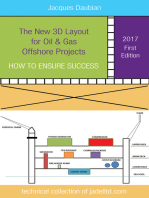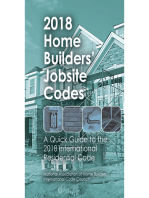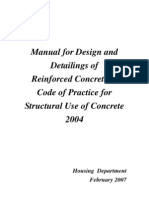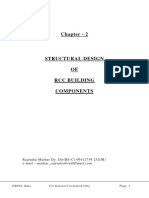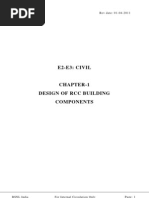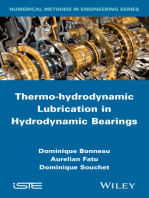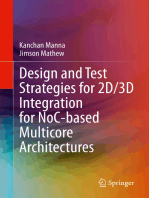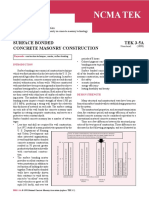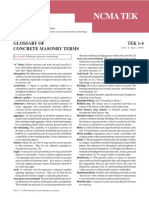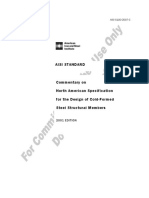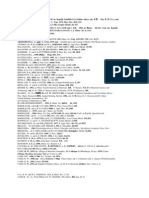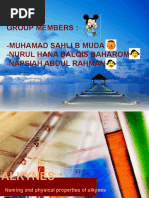0 ratings0% found this document useful (0 votes)
75 viewsBuilding Code Requirements For Concrete Masonry: TEK 1-3D
Building Code Requirements For Concrete Masonry: TEK 1-3D
Uploaded by
jerryThe document discusses changes to concrete masonry provisions between the 2008 and 2011 editions of the Masonry Standards Joint Committee (MSJC) code and specification, which form the basis for the International Building Code. Key changes include:
1) Additional quality assurance requirements and inspection frequencies were added to the MSJC specification tables.
2) Provisions for self-consolidating grout and minimum lap lengths for bed joint reinforcement were incorporated.
3) A grout key is now required when grout is permitted to set between pours.
4) Minor revisions were made to concrete masonry design provisions, including limits on flexural reinforcement and inclusion of openings in empirically designed shear walls
Copyright:
© All Rights Reserved
Available Formats
Download as PDF, TXT or read online from Scribd
Building Code Requirements For Concrete Masonry: TEK 1-3D
Building Code Requirements For Concrete Masonry: TEK 1-3D
Uploaded by
jerry0 ratings0% found this document useful (0 votes)
75 views4 pagesThe document discusses changes to concrete masonry provisions between the 2008 and 2011 editions of the Masonry Standards Joint Committee (MSJC) code and specification, which form the basis for the International Building Code. Key changes include:
1) Additional quality assurance requirements and inspection frequencies were added to the MSJC specification tables.
2) Provisions for self-consolidating grout and minimum lap lengths for bed joint reinforcement were incorporated.
3) A grout key is now required when grout is permitted to set between pours.
4) Minor revisions were made to concrete masonry design provisions, including limits on flexural reinforcement and inclusion of openings in empirically designed shear walls
Original Title
TEK 01-3D
Copyright
© © All Rights Reserved
Available Formats
PDF, TXT or read online from Scribd
Share this document
Did you find this document useful?
Is this content inappropriate?
The document discusses changes to concrete masonry provisions between the 2008 and 2011 editions of the Masonry Standards Joint Committee (MSJC) code and specification, which form the basis for the International Building Code. Key changes include:
1) Additional quality assurance requirements and inspection frequencies were added to the MSJC specification tables.
2) Provisions for self-consolidating grout and minimum lap lengths for bed joint reinforcement were incorporated.
3) A grout key is now required when grout is permitted to set between pours.
4) Minor revisions were made to concrete masonry design provisions, including limits on flexural reinforcement and inclusion of openings in empirically designed shear walls
Copyright:
© All Rights Reserved
Available Formats
Download as PDF, TXT or read online from Scribd
Download as pdf or txt
0 ratings0% found this document useful (0 votes)
75 views4 pagesBuilding Code Requirements For Concrete Masonry: TEK 1-3D
Building Code Requirements For Concrete Masonry: TEK 1-3D
Uploaded by
jerryThe document discusses changes to concrete masonry provisions between the 2008 and 2011 editions of the Masonry Standards Joint Committee (MSJC) code and specification, which form the basis for the International Building Code. Key changes include:
1) Additional quality assurance requirements and inspection frequencies were added to the MSJC specification tables.
2) Provisions for self-consolidating grout and minimum lap lengths for bed joint reinforcement were incorporated.
3) A grout key is now required when grout is permitted to set between pours.
4) Minor revisions were made to concrete masonry design provisions, including limits on flexural reinforcement and inclusion of openings in empirically designed shear walls
Copyright:
© All Rights Reserved
Available Formats
Download as PDF, TXT or read online from Scribd
Download as pdf or txt
You are on page 1of 4
Provided
An i n f o r m aby:
tion series from the national authority on concrete masonry technology
Domine Builders Supply
BUILDING CODE REQUIREMENTS TEK 1-3D
FOR CONCRETE MASONRY Codes & Specs (2011)
INTRODUCTION concrete masonry provisions made between the 2008 and
2011 editions of the MSJC code and specification. Note
The majority of jurisdictions in the United States that the scope of the MSJC code and specification covers
adopt a national model code, most commonly the Inter- structural design and construction. Hence, requirements
national Building Code (IBC) (refs. 1, 2), as the basis of for items such as fire resistance, sound insulation and
their building code. The intent of the IBC is to reference energy efficiency are not addressed in the MSJC docu-
and coordinate other standardized documents, rather ments.
than to develop design and construction provisions from
scratch. With this in mind, the IBC masonry design and
construction provisions are based primarily on Building
Code Requirements for Masonry Structures (MSJC code) Consensus process
(refs. 3, 4) and Specification for Masonry Structures N
(MSJC specification) (refs. 5, 6). a
The code adoption process is shown schematically in t
i
Figure 1. In adopting the MSJC code and specification,
o
the IBC can amend or modify some provisions. Similarly, n
depending on state laws, modifications can be made a MSJC Code and
to the IBC at the state or local level to better suit local l Specification
building practices or design traditions. However, most
p
state codes require that any modifications to the IBC be r
adoption with modifications
more stringent than the corresponding requirement in and additions
o
the IBC. c
Because significant changes can be introduced into e International
subsequent editions of both the MSJC and IBC, the s Building Code
s
edition referenced by the local building code can be an
important consideration when determining the specific adoption, possibly
requirements to be met. Note that code officials will often with modifications
accept more current design and construction standards State/
local State or Local
than those referenced in the code, as they represent more
process Building Code
state-of-the-art requirements for a specific material or
system.
To help determine which code provisions apply and
highlight changes of note, this TEK outlines the major
modifications to concrete masonry provisions of the Figure 1—Masonry Structural Code
2009 and 2012 IBC, as well as the principal changes to Development Process
Related TEK: Keywords: building codes, construction, masonry design,
1-2C, 9-2B, 12-6, quality assurance, specifications
14-7C
NCMA TEK 1-3D 1
2009 INTERNATIONAL BUILDING CODE provisions previously in Chapter 2 (allowable stress
design) were deleted. The pseudo-strength design
The 2009 International Building Code (ref. 1) adopts method provided a method that the user could apply
by reference the 2008 editions of the MSJC code and to scale the allowable stress design values up to a cor-
MSJC specification (refs. 3, 5). The MSJC code covers responding strength-level design for application with
the design of concrete masonry, clay masonry, glass unit factored loads.
masonry, stone masonry, autoclaved aerated concrete • To help ensure the uniform distribution of prestressing
(AAC), as well as masonry veneer. The MSJC code forces, prestressed masonry is required to be laid in
requires compliance with the MSJC specification, which running bond unless a bond beam or other technique
governs masonry construction requirements and quality is used to distribute anchorage forces.
assurance provisions (see also TEK 1-2C, ref. 7).
Previous editions of the IBC either contained many Construction and Quality Assurance
of the same provisions as the MSJC, or contained conflict- Specification revisions relative to concrete masonry
ing provisions. The majority of the changes incorporated included:
into the 2009 IBC were made to remove the redundant • Tables 3, 4 and 5, outlining quality assurance require-
language and instead directly reference the MSJC. ments now include a minimum inspection frequency for
In addition, a reference to TMS 0302, Standard Method each inspection task. Inspection frequencies are either:
for Determining the Sound Transmission Class Rating for periodic, requiring intermittent observation of masonry
Masonry Walls (ref. 8), was included in the 2009 IBC for work; or continuous, requiring full-time presence in the
the first time. area while masonry work is underway. The tables were
also reformatted for clarity.
The 2008 MSJC Code and Specification • The specification now allows bending of foundation
Compared to earlier editions of the MSJC code and dowels, up to 1 in. (25 mm) horizontally for each 6 in.
specification, updates included in the 2008 edition are (152 mm) of vertical height. This provision is similar
summarized below. to that used for reinforced concrete construction.
• Provisions for the use of self-consolidating grout
Masonry Design were incorporated into the 2008 MSJC specification.
Changes to concrete masonry design provisions Self-consolidating grout is a specially-formulated ma-
included: sonry grout which does not require consolidation and
• For flexurally dominated (M/Vd > 1.0) special rein- reconsolidation by mechanical vibration or puddling.
forced masonry shear walls designed by the allowable See TEK 9-2B, Self-Consolidating Grout for Concrete
stress design method, a limit on the maximum flexural Masonry (ref. 9) for more information.
reinforcement used to resist in-plane loads was intro- • Previous masonry codes have required that grout be
duced. This limit does not apply when the axial load placed within 1.5 hours after water is introduced to the
is less than or equal to 0.05f'mAn or when checking the mix. The 2008 specification waives this requirement
reinforcement ratio in the out-of-plane direction. for transit-mixed grout as long as it meets the specified
• A moment magnifier approach to determining P-delta slump requirement.
effects was introduced for the design of unreinforced • The 2008 specification requires a grout key when grout
masonry using the strength design method. This pro- is permitted to set between pours (grout keys are not
cedure is presented as an alternative to a more compre- permitted within masonry bond beams or lintels). The
hensive second-order analysis for determining bending grout key helps provide structural continuity between
moments. the grout pours. This provision was previously only in
• Provisions for checking the size and spacing of open- the IBC.
ings in empirically designed masonry shear walls were • A minimum lap length of 6 in. (152 mm) for splicing
added into the 2008 MSJC code. Previous editions were bed joint reinforcement was introduced. Previous edi-
silent on the incorporation of openings in empirically tions were silent on determining minimum lap length
designed masonry shear walls. of wire reinforcement.
• With the adoption of a formal strength design proce-
dure into the MSJC code, the pseudo-strength design
2 NCMA TEK 1-3D
Differences Between the 2009 IBC and the 2008 reserved for commentary. Hence, commentary appears
MSJC directly next to the applicable text, rather than in a separate
The 2008 editions of the MSJC code and specifica- section at the back of the document. Other substantive
tion are included in their entirety (by reference) in the changes are summarized below.
2009 IBC. The IBC modifies several areas of the MSJC
code and specification applicable to concrete masonry. Masonry Design
The most significant of these are summarized below. In
• Allowable stresses (Chapter 2) were recalibrated, re-
addition, quality assurance provisions are close, but not
sulting in the removal of the 1/3 stress increase for load
identical between the IBC and MSJC.
combinations including wind or seismic loads. Hence,
Allowable Stress Design the ongoing conflict between the MSJC allowable stress
For masonry designed using allowable stress design design loading provisions which permitted the 1/3 stress
procedures, the IBC: increase and the ASCE 7-05 (ref. 10) prohibition of the
• modifies load combinations to be based on IBC section 1
/3 stress increase was eliminated. The MSJC commit-
1605, rather than those in MSJC code section 2.1.2.1, tee used both research data and trial designs as a basis
• modifies minimum inspections required during construc- for the revisions. The correlation between the strength
tion, predicted by the equations and the values bound by test
• modifies the minimum required lap splice length for is much better with the new provisions and this should
reinforcing bars. See TEK 12-6, Splices, Development increase confidence in the design. See TEK 14-7C, Al-
and Standard Hooks for Concrete Masonry (ref. 12),
lowable Stress Design of Concrete Masonry Based on
for more detailed information, and
the 2012 IBC & 2011 MSJC (ref. 11) for more detailed
• sets a maximum reinforcing bar size based on the size
of the cell or collar joint where the reinforcement is information.
placed. • Allowable stress design and strength design shear
provisions were harmonized. See TEK 14-7C for more
Strength Design information.
For masonry designed using strength design proce- • A new Appendix B, Design of Masonry Infill, was added.
dures, the IBC modifies welded and mechanical splice • Provisions for the design of deep beams were added.
requirements. Lap splices were modified such that they • Lap splices are permitted to be reduced where transverse
need not be longer than 72 bar diameters. reinforcement is placed within 8 in. (203 mm) of the end
of the splice if it is fully developed in grouted masonry.
Empirical Design • The beneficial effect of larger cover for computation of
For empirically designed elements, the IBC includes
development length was changed.
provisions for empirically-designed surface-bonded ma-
• Strength of reinforcement in compression is permitted
sonry walls and for adobe construction.
when checking the maximum reinforcement requirement
but is still ignored when computing nominal strength.
2012 International Building Code
• Commentary guidance on seismic coefficients for pre-
stressed masonry shear walls was added.
The 2012 International Building Code (ref. 2) adopts
by reference the 2011 editions of the MSJC code and MSJC
Construction and Quality Assurance
specification (refs. 4, 6). The following section highlights
• Anchor bolt installation requirements were revised.
the major changes between the 2008 and 2011 MSJC code
• For walls with laterally restrained or laterally unre-
and specification.
strained unbounded prestressing tendons, a revised
The 2012 IBC revisions to the MSJC remain largely
equation was incorporated in the document.
unchanged from the 2009 IBC. In IBC Chapter 17, Struc-
• Clarification was added to indicate that drips are not
tural Tests and Special Inspections, detailed inspection
permitted in wire anchors and joint reinforcement cross
requirements were removed. The chapter now refers the
wires and tabs.
user to the MSJC specification for inspection requirements.
• Provisions for single pintle anchors were added.
• Grout pour heights were increased slightly to 5' 4" (1.63
The 2011 MSJC Code and Specification
m) to accommodate modular construction dimensions.
The format of the 2011 edition was substantially
• Prism testing provisions for specimens cut from con-
changed, in that the right-hand side of each page is now
struction were included.
NCMA TEK 1-3D 3
REFERENCES
1. International Building Code 2009. International Code Council, 2009.
2. International Building Code 2012. International Code Council, 2012.
3. Building Code Requirements for Masonry Structures, TMS 402-08/ACI 530-08/ASCE 5-08. Reported by the Masonry
Standards Joint Committee, 2008.
4. Building Code Requirements for Masonry Structures, TMS 402-11/ACI 530-11/ASCE 5-11. Reported by the Masonry
Standards Joint Committee, 2011.
5. Specification for Masonry Structures, TMS 602-08/ACI 530.1-08/ASCE 6-08. Reported by the Masonry Standards Joint
Committee, 2008.
6. Specification for Masonry Structures, TMS 602-11/ACI 530.1-11/ASCE 6-11. Reported by the Masonry Standards Joint
Committee, 2011.
7. Specification for Masonry Structures, TEK 1-2C. National Concrete Masonry Association, 2010.
8. Standard Method for Determining the Sound Transmission Class Rating for Masonry Walls, TMS 0302-07. The Masonry
Society, 2007.
9. Self-Consolidating Grout for Concrete Masonry, TEK 9-2B. National Concrete Masonry Association, 2007.
10. Minimum Design Loads for Buildings and Other Structures, ASCE 7-05. American Society of Civil Engineers, 2005.
11. Allowable Stress Design of Concrete Masonry Based on the 2012 IBC & 2011 MSJC, TEK 14-7C. National Concrete
Masonry Association, 2011.
12. Splices, Development and Standard Hooks for Concrete Masonry, TEK 12-6. National Concrete Masonry Association,
2007.
NCMA and the companies disseminating this technical information disclaim any and all responsibility and liability for the
accuracy and the application of the information contained in this publication.
NATIONAL CONCRETE MASONRY ASSOCIATION
13750 Sunrise Valley Drive, Herndon, Virginia 20171
www.ncma.org
To order a complete TEK Manual or TEK Index, contact NCMA Publications (703) 713-1900
Provided by: Domine Builders Supply
4 NCMA TEK 1-3D
You might also like
- IS 3370 (Part 2) - 2021Document22 pagesIS 3370 (Part 2) - 2021Praveen Agarwal93% (15)
- ACI 318-56 Building Code Requirements For Reinforced ConcreteDocument39 pagesACI 318-56 Building Code Requirements For Reinforced ConcretejerryNo ratings yet
- A Practical Guide to Concrete Pavement Technology for Developing CountriesFrom EverandA Practical Guide to Concrete Pavement Technology for Developing CountriesNo ratings yet
- Reinforced Concrete Buildings: Behavior and DesignFrom EverandReinforced Concrete Buildings: Behavior and DesignRating: 5 out of 5 stars5/5 (1)
- The New 3D Layout for Oil & Gas Offshore Projects: How to ensure successFrom EverandThe New 3D Layout for Oil & Gas Offshore Projects: How to ensure successRating: 4.5 out of 5 stars4.5/5 (3)
- Tek 01-03C PDFDocument4 pagesTek 01-03C PDFFNo ratings yet
- Specification For Masonry Structures: TEK 1-2CDocument4 pagesSpecification For Masonry Structures: TEK 1-2CjerryNo ratings yet
- Review of Design Codes For MasonryDocument23 pagesReview of Design Codes For MasonrySourabhAdikeNo ratings yet
- Manual For Design and Detailing of RCCDocument340 pagesManual For Design and Detailing of RCCimranmehfooz100% (2)
- Concrete PDFDocument340 pagesConcrete PDFee2100% (1)
- NCC2022 Changes - CMAADocument2 pagesNCC2022 Changes - CMAAMoren AlfonsoNo ratings yet
- Practical Design & Detailing Manual 2013Document340 pagesPractical Design & Detailing Manual 2013FWICIPNo ratings yet
- Masonry Codes Reviewed in This StudyDocument1 pageMasonry Codes Reviewed in This StudySujay SantraNo ratings yet
- RCC Design HandbookDocument346 pagesRCC Design Handbookmoizm5350% (2)
- HD Manual - COP For Structure Use of Concrete 2004 Rev - 2.3Document346 pagesHD Manual - COP For Structure Use of Concrete 2004 Rev - 2.3yin169No ratings yet
- Design Manual To CoP2004 (Housing)Document265 pagesDesign Manual To CoP2004 (Housing)jjj201187No ratings yet
- Concrete Manual 2004 PDFDocument346 pagesConcrete Manual 2004 PDFLau Kim HwaNo ratings yet
- CI4108 MoehleDocument7 pagesCI4108 MoehleAnonymous whmDU3ZNo ratings yet
- STR-M - Structural Masonry General NotesDocument3 pagesSTR-M - Structural Masonry General NotesFWICIPNo ratings yet
- 1343-2012 Prestressed ConcreteDocument62 pages1343-2012 Prestressed Concretekapinjal_No ratings yet
- Potres ZidoviDocument23 pagesPotres ZidoviIvan KelamNo ratings yet
- Design Standards For Box CulvertsDocument4 pagesDesign Standards For Box CulvertsCT0011No ratings yet
- Is 1343-2012-Code of Practice For Pre Stressed ConcreteDocument69 pagesIs 1343-2012-Code of Practice For Pre Stressed ConcreteShankar L DhaasharathNo ratings yet
- PTA Guidance Note GN02Document2 pagesPTA Guidance Note GN02Sheik Mohamed LiakathNo ratings yet
- Cutting Edge Masonry Codes and StandardsDocument70 pagesCutting Edge Masonry Codes and StandardsMuhammad MurtazaNo ratings yet
- KDS 14 20 20 콘크리트구조 휨 및 압축 설계기준Document28 pagesKDS 14 20 20 콘크리트구조 휨 및 압축 설계기준poit0987No ratings yet
- Design and Detailing of Reinforced ConcrDocument346 pagesDesign and Detailing of Reinforced ConcrNashid LibertyNo ratings yet
- PCI Chapter 14Document20 pagesPCI Chapter 14Sergio Adolfo ParedesNo ratings yet
- Structural Design of RCC Building ComponentsDocument9 pagesStructural Design of RCC Building ComponentsAHSANNo ratings yet
- Precast Handbook 1Document10 pagesPrecast Handbook 1rameshkaaNo ratings yet
- KDS 14 20 62 Structural Design Standard For Precast ConcreteDocument10 pagesKDS 14 20 62 Structural Design Standard For Precast ConcreteSol TianNo ratings yet
- KDS 14 20 22 콘크리트구조 전단 및 비틀림 설계기준Document35 pagesKDS 14 20 22 콘크리트구조 전단 및 비틀림 설계기준poit0987No ratings yet
- Review of Building Codes NZ PDFDocument59 pagesReview of Building Codes NZ PDFbugstarsNo ratings yet
- Chapter - 2 Structural Design of RCC BuilDocument72 pagesChapter - 2 Structural Design of RCC BuilIREH MICHAELNo ratings yet
- Design of RCC Building ComponentsDocument66 pagesDesign of RCC Building Componentsasdfg1h80% (10)
- Durability Design of Concrete Structures: Phenomena, Modeling, and PracticeFrom EverandDurability Design of Concrete Structures: Phenomena, Modeling, and PracticeNo ratings yet
- Spot Welding Interview Success: An Introduction to Spot WeldingFrom EverandSpot Welding Interview Success: An Introduction to Spot WeldingNo ratings yet
- Modernisation, Mechanisation and Industrialisation of Concrete StructuresFrom EverandModernisation, Mechanisation and Industrialisation of Concrete StructuresNo ratings yet
- Hand Book For Steel Structure Quality Control on SiteFrom EverandHand Book For Steel Structure Quality Control on SiteNo ratings yet
- Infrastructure Systems for Nuclear EnergyFrom EverandInfrastructure Systems for Nuclear EnergyRating: 4.5 out of 5 stars4.5/5 (2)
- Ceramic Integration and Joining Technologies: From Macro to NanoscaleFrom EverandCeramic Integration and Joining Technologies: From Macro to NanoscaleNo ratings yet
- Sustainable Steel Buildings: A Practical Guide for Structures and EnvelopesFrom EverandSustainable Steel Buildings: A Practical Guide for Structures and EnvelopesBernhard HaukeNo ratings yet
- Visual Media Coding and TransmissionFrom EverandVisual Media Coding and TransmissionAhmet KondozNo ratings yet
- Joint Photographic Experts Group: Unlocking the Power of Visual Data with the JPEG StandardFrom EverandJoint Photographic Experts Group: Unlocking the Power of Visual Data with the JPEG StandardNo ratings yet
- Introduction to Design of Building StructuresFrom EverandIntroduction to Design of Building StructuresRating: 4 out of 5 stars4/5 (22)
- Nanotechnology Commercialization: Manufacturing Processes and ProductsFrom EverandNanotechnology Commercialization: Manufacturing Processes and ProductsNo ratings yet
- Flat Panel Display ManufacturingFrom EverandFlat Panel Display ManufacturingJun SoukNo ratings yet
- Design and Test Strategies for 2D/3D Integration for NoC-based Multicore ArchitecturesFrom EverandDesign and Test Strategies for 2D/3D Integration for NoC-based Multicore ArchitecturesNo ratings yet
- Papers on the field QoS Measurement Of Services in mobile networks Using Aggregation MethodFrom EverandPapers on the field QoS Measurement Of Services in mobile networks Using Aggregation MethodRating: 4 out of 5 stars4/5 (2)
- Concrete Pipes, Bricks & Blocks World Summary: Market Values & Financials by CountryFrom EverandConcrete Pipes, Bricks & Blocks World Summary: Market Values & Financials by CountryNo ratings yet
- Post Weld Heat Treatment PWHT: Standards, Procedures, Applications, and Interview Q&AFrom EverandPost Weld Heat Treatment PWHT: Standards, Procedures, Applications, and Interview Q&ANo ratings yet
- Flexible Glass: Enabling Thin, Lightweight, and Flexible ElectronicsFrom EverandFlexible Glass: Enabling Thin, Lightweight, and Flexible ElectronicsSean M. GarnerNo ratings yet
- Ncma Tek: Bracing Concrete Masonry Walls During Construction TEK 3-4BDocument6 pagesNcma Tek: Bracing Concrete Masonry Walls During Construction TEK 3-4BjerryNo ratings yet
- Ncma Tek: Surface Bonded Concrete Masonry Construction TEK 3-5ADocument4 pagesNcma Tek: Surface Bonded Concrete Masonry Construction TEK 3-5AjerryNo ratings yet
- TEK 03-2A Grouting Concrete Masonry WallsDocument6 pagesTEK 03-2A Grouting Concrete Masonry WallsjerryNo ratings yet
- Ncma Tek: Segmental Retaining Wall Units TEK 2-4BDocument4 pagesNcma Tek: Segmental Retaining Wall Units TEK 2-4BjerryNo ratings yet
- Considerations For Using Specialty Concrete Masonry Units: TEK 2-2BDocument4 pagesConsiderations For Using Specialty Concrete Masonry Units: TEK 2-2BjerryNo ratings yet
- Ncma Tek: TEK 3-1C All-Weather Concrete Masonry ConstructionDocument4 pagesNcma Tek: TEK 3-1C All-Weather Concrete Masonry ConstructionjerryNo ratings yet
- Ncma Tek: Architectural Concrete Masonry Units Tek 2-3ADocument4 pagesNcma Tek: Architectural Concrete Masonry Units Tek 2-3AjerryNo ratings yet
- Ncma Tek: Typical Sizes and Shapes of Concrete Masonry Units TEK 2-1ADocument4 pagesNcma Tek: Typical Sizes and Shapes of Concrete Masonry Units TEK 2-1AjerryNo ratings yet
- Ncma Tek: Glossary of Concrete Masonry Terms TEK 1-4Document6 pagesNcma Tek: Glossary of Concrete Masonry Terms TEK 1-4jerryNo ratings yet
- Astm Specifications For Concrete Masonry Units: TEK 1-1FDocument4 pagesAstm Specifications For Concrete Masonry Units: TEK 1-1FjerryNo ratings yet
- Guide For Evaluation of Concrete Structures Prior To RehabilitationDocument22 pagesGuide For Evaluation of Concrete Structures Prior To RehabilitationjerryNo ratings yet
- AISI S100-07 CommentaryDocument216 pagesAISI S100-07 CommentaryjerryNo ratings yet
- AISI S211-07 Errata PDFDocument2 pagesAISI S211-07 Errata PDFjerryNo ratings yet
- MSC Steel Interchange - Overstrength Requirement For Seismic Design of DiaphragmsDocument1 pageMSC Steel Interchange - Overstrength Requirement For Seismic Design of DiaphragmsjerryNo ratings yet
- Aci 548.3R-03Document40 pagesAci 548.3R-03jerryNo ratings yet
- BW FinishOne+Passivator+630 EN 2022 GL 152 PreviewDocument2 pagesBW FinishOne+Passivator+630 EN 2022 GL 152 PreviewDenny AgusNo ratings yet
- PDFDocument18 pagesPDFQuy Hoang KimNo ratings yet
- Retaining Wall Counterfort DESIGN-BKSDocument48 pagesRetaining Wall Counterfort DESIGN-BKSBhavanishankar ShettyNo ratings yet
- Lecture 8 - 1st Law of Thermodyanmics - Joule Thomson Effect Updated 04-30-2020Document48 pagesLecture 8 - 1st Law of Thermodyanmics - Joule Thomson Effect Updated 04-30-2020Vicente JonathanNo ratings yet
- Structural Calculation Report of Platform Str-2Document91 pagesStructural Calculation Report of Platform Str-2SaifullahNo ratings yet
- Inbound 2548543278908560318Document3 pagesInbound 2548543278908560318Nathaniel AlquezaNo ratings yet
- FiltersDocument28 pagesFiltersMarceloGonçalvesNo ratings yet
- Samsung Novec1230Document1 pageSamsung Novec1230Quang Thịnh BùiNo ratings yet
- LCC Pump Series - : Wear Resistant, High Performance Slurry PumpsDocument8 pagesLCC Pump Series - : Wear Resistant, High Performance Slurry Pumpshassen gannouniNo ratings yet
- Profesor: David Wong DiazDocument73 pagesProfesor: David Wong DiazLuis AlmengorNo ratings yet
- Chemistry of Transition and Inner Transition Elements+.Document60 pagesChemistry of Transition and Inner Transition Elements+.Nidhi Singh67% (9)
- Common Errors in Hydronic Radiant Panel Heating Systems John-SiegenthalerDocument35 pagesCommon Errors in Hydronic Radiant Panel Heating Systems John-SiegenthalerJM100% (1)
- EDEM Hysteretic ModelDocument6 pagesEDEM Hysteretic ModelDaniel Zambra ZambraNo ratings yet
- Lewis, K. K.: AkhtarDocument5 pagesLewis, K. K.: AkhtarGirish HvNo ratings yet
- Green University of Bangladesh: Department of Textile EngineeringDocument9 pagesGreen University of Bangladesh: Department of Textile EngineeringGreen University TextileNo ratings yet
- Sample Questions - Chapter 2Document5 pagesSample Questions - Chapter 2Rasel IslamNo ratings yet
- ITT Cannon D Subminiature Products-1869325Document62 pagesITT Cannon D Subminiature Products-1869325asepNo ratings yet
- Chapter 7 Pure SubstanceDocument22 pagesChapter 7 Pure SubstanceMUHAMMED FAISALNo ratings yet
- B-16-04884 KMT Tungsten Heavy Alloy Brochure EN LRPDFDocument12 pagesB-16-04884 KMT Tungsten Heavy Alloy Brochure EN LRPDFSina RashidiNo ratings yet
- Chapter 05 SolDocument9 pagesChapter 05 SolVioletta ViollaNo ratings yet
- Desalting Part 1 May 2009Document104 pagesDesalting Part 1 May 2009ermusatNo ratings yet
- Ultrasonics Sonochemistry: Manisha V. Bagal, Parag R. GogateDocument14 pagesUltrasonics Sonochemistry: Manisha V. Bagal, Parag R. GogateBhaskar BethiNo ratings yet
- Coal Bed MethaneDocument104 pagesCoal Bed MethaneAkhil GodavarthiNo ratings yet
- Spider Silk - An Unconventional FiberDocument16 pagesSpider Silk - An Unconventional FiberShubhi SethiNo ratings yet
- Sni Sand ConeDocument1 pageSni Sand ConeDanny Alwan100% (1)
- Frother Effects On Bubble Size Estimation in A Flotation ColumnDocument13 pagesFrother Effects On Bubble Size Estimation in A Flotation ColumnJose Luis Barrientos RiosNo ratings yet
- Chemical Synthesis of Vanadium Oxide (V2O5) Nanoparticles Prepared by Sodium MetavanadateDocument5 pagesChemical Synthesis of Vanadium Oxide (V2O5) Nanoparticles Prepared by Sodium MetavanadateFriska Ade UvianaNo ratings yet
- Group Members: - Muhamad Sahli B Muda - Nurul Hana Balqis Baharom - Napsiah Abdul RahmanDocument18 pagesGroup Members: - Muhamad Sahli B Muda - Nurul Hana Balqis Baharom - Napsiah Abdul RahmanNurul Hana BalqisNo ratings yet
- Stray Current MagazineDocument13 pagesStray Current MagazineRoberto ArmentaNo ratings yet
- 15晶圓與晶片測試Document19 pages15晶圓與晶片測試機械系龔昭銘No ratings yet






